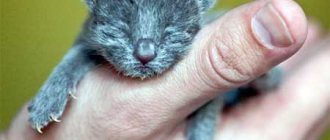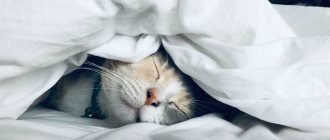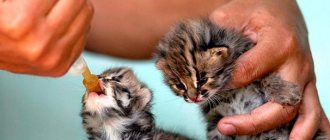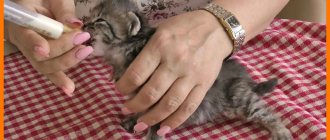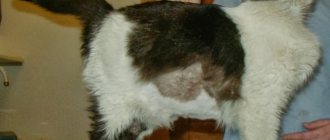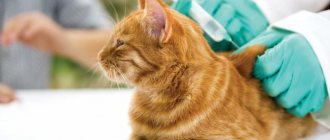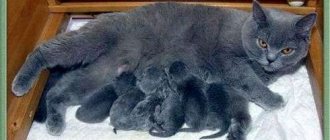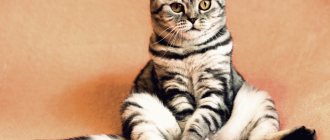Flattening of the sternum in kittens. Flat chest The baby was born fifth, with a very strong crease in the tail. Otherwise, a normal cat, healthy, large. He gained weight well and grew at the same rate as everyone else. On the 8th day, he developed flat chest syndrome (FCK - Flat Chested Kitten). We don’t like to write about defects, so it was difficult to figure out how to deal with it further. In most cases, flattening appears from the 2nd to the 10th day from birth. It’s hard not to notice, because the kitten has flat ribs, with varying degrees of severity. In the picture from left to right: regular rib cage, flattened sternum, funnel-shaped sternum.
As you can see, the degree of manifestation of this syndrome can be different; the survival rate of kittens depends on the degree of severity. The ribs can be completely flat underneath and even curl inward into the chest (funnel chest).
The critical age for kittens with FCKS is 3 weeks and 4 months. At 3 weeks, kittens with a very severe syndrome die due to difficulty breathing and, as a result, insufficient oxygen supply. At 4 months, kittens die from compression of the lungs, and, as foreign sources write, from inversion of the sternum into the chest, disruption of the diaphragm and compression of the heart. If the kitten experiences a critical age, then it grows into a normal healthy cat, like any of its siblings. They also say that with age, the back and ribs return to normal and no one will notice that the kitten had any problems in childhood.
flat chest
a depression on the back behind the shoulder blades (the fact is that, as can be seen in the picture above, flattening occurs both above and below. Sometimes the back is more convex, sometimes flatter)
difficulty and rapid breathing
decreased activity, apathy
significant growth retardation
kittens are generally in poorer condition than their littermates
the legs are spread apart, like in amphibians (the syndrome is also popularly called “turtle chest”; the ribs in the thoracic region resemble a turtle shell)
Where does it come from? The reasons for the birth of a kitten with flat chest syndrome may vary, but it is impossible to determine the exact cause. The following theoretically possible reasons have been put forward: Environment - the cause of the syndrome may be factors such as a too flat hard surface in the “nest”, at too high a temperature. In such conditions, kittens scatter in different directions and lie down on their backs, while at normal temperatures they lie all together, or in pairs, often changing positions. The mother's constant presence in the nest, as a result, the kitten can lie in one position for a long time. It is also believed that bacteria or viruses can cause this side effect.
Nutrition - perhaps the pregnant cat’s diet lacked important vitamins and minerals, or they were not absorbed for some reason. Hypotheses have been put forward about a lack of Selenium, taurine or calcium. However, there is no practical evidence of this.
Genetics – It is possible that FCKS or a predisposition to it is inherited genetically. Polygenic inheritance is possible, but autosomal recessive inheritance can also be assumed.
Caring for kittens with flattened chest syndrome (FCKS) Foreign sources offer different methods. They suggest putting a bandage on kittens made from the frame of a toilet paper roll in order to give the chest a round shape, you can also do massages, and it is also believed that swimming will help improve the tone of the intercostal muscles.
Flattening of the chest in kittens, popularly called swimmer's syndrome, most often appears 2-10 days after birth. A characteristic sign of this pathology is flat ribs. Whether the small pet will survive depends on the degree of dorsoventral flattening of the chest. The animal often dies because breathing becomes difficult.
Why does swimmer's syndrome occur?
Most often, the disease is observed in the Bengal or Oriental breed.
Flat chest syndrome occurs in kittens for a number of reasons. Breeders and veterinarians cannot accurately determine the factors that provoke pathology. But experts highlight some of them:
- Very hard surface in the habitat, unsuitable temperature. Kittens sleep separately from each other, and when the temperature is normal they settle together. The kitten spends time in one position for a long time.
- During pregnancy, the cat did not receive the required amount of vitamins or they were poorly absorbed.
- Hereditary predisposition.
- Respiratory tract infections, pneumonia.
- Colic. Air enters the stomach instead of the lungs, making breathing difficult.
- Diaphragmatic spasm.
Causes of the disease
Rickets can be congenital (primary) or acquired (secondary). In the first case, the cause is an unbalanced diet of a pregnant cat (for example, lack of essential amino acids or protein deficiency), which is why kittens already appear with a congenital disease.
Acquired rickets occurs in kittens in the first months. Its common causes include:
- Unbalanced diet.
Rickets often occurs in pets whose diet does not contain enough calcium and phosphorus. Pathology can occur with a premature transition to “adult” food, insufficient feeding with mother’s milk, or the absence of dairy and fish products.
- Poor care.
Any factors that provoke a slowdown in metabolic processes in kittens can provoke rickets. These include insufficient lighting in the room, problems with ventilation and high levels of humidity.
- Gastrointestinal diseases.
Infectious and parasitic diseases lead to the development of inflammation. They disrupt the functions of the gastrointestinal tract and affect the absorption of nutrients and vitamins, which can cause rickets.
- Artificial feeding.
Often, owners use artificial milk substitutes that do not meet the needs of kittens. This leads to the fact that the metabolism in their body is disrupted and rickets gradually develops.
Treatment of syndrome in kittens
Dangerous age is from 3 weeks to 4 months. Kittens die within a month from lack of oxygen. At 16 weeks, they die from compression of parts of the body, in which the lungs cannot fully function. If kittens survive this period, then as they grow older, the chest deformation becomes less noticeable. Swimmer's syndrome will disappear and the pet will be no different from other animals. In the future, no one will know that the cat had a flattened chest as a child.
Treatment most often consists of a course of massage. The kitten should not lie on its tummy, only on its side. If diaphragmatic spasm occurs, it is necessary to pinch the bundle of muscles running from the neck to the shoulder. The spasm will be eliminated instantly; you will have to do this every time until the deformity is corrected. Sometimes the baby will need to be placed in a special corset. This will help the lungs work normally, and the thoracic part of the body will be expanded. But only a doctor should prescribe a corset.
Until 2010, the cause of flat chest was considered to be spasm of the intercostal muscles.
Diagnostics
Diagnostic procedures provide a chance to establish the xiphoid process. To do this, you need to contact a veterinarian who will conduct an examination using the following methods:
- Physical. The appearance and condition of the organs are examined, symptoms are recorded according to the owner.
- Laboratory. Urine test to determine potassium and phosphorus levels.
- Using a stethoscope. Listen to heartbeat, breathing, bowel sounds. At such a moment, complete silence is necessary, any sound will interfere, and the diagnosis will be incorrect.
- Using an endoscope. Makes it possible to check the stomach, esophagus, and respiratory organs. This procedure is carried out under anesthesia so as not to harm the animal.
- X-ray. It is used to examine the pet's internal organs.
- Ultrasound. Necessary for cats who are pregnant to check fetal development.
- ECG. Sensors are attached to the cat, with the help of which the functioning of its heart is checked.
If the deviations are small, then the kitten remains active. As they get older they become less noticeable. If the deformation was obvious in a small cat, then in an adult it is almost invisible.
Maintenance and care
A kitten with swimmer's syndrome needs to have its chest massaged every day; after a few days, it will be noticeable that the ribs on the sides will begin to smooth out. The main thing is to help the baby get on his feet, then he will move and the muscles will begin to strengthen. You can make barriers in their home so that the kitten can overcome the barrier. Try to place your small pet on its side to sleep, increasing the time it stays in this position; a compressed chest prevents you from breathing fully.
The veterinarian will prescribe a corset that will help the baby breathe normally. The doctor will recommend the use of antibiotics. This promotes the development of the animal and will help get rid of possible infections. Drug therapy will help to gain weight, the pet will begin to eat well. If you take full care of a sick kitten, you can get results within a few days. If you don’t work hard, it will take 3 months.
Useful articles for your pet
Treatment options
If a disease is detected, you should immediately contact a veterinarian. He will be able to make a more accurate diagnosis. Treatment occurs in two ways:
- The first is physical. It is a massage that is performed daily. This involves bending the paws and massaging them in the correct position. This method lengthens and weakens the muscles of the limbs. If the legs are spread out and the baby is constantly lying down, he is turned on his side and held that way for some time.
- The second is surgical. Used when the initial option did not help. Prescribed only to pets older than 8 weeks. Designed to correct breast deformities.
ZooForum: A newborn kitten has a depressed chest - ZooForum
(others can give advice in a PM, indicating that the advice is not given by a veterinarian. But the forum is not responsible for THESE advice.)
A newborn kitten has a depressed chest
Hello, please help me understand the cause of the problem in the kitten, which I myself cannot understand. I mated my cat with a new cat, the kittens were born all normal. On the seventh day after giving birth, one kitten attracted my attention; he was lying in a pile of babies and breathing more often than others, and when I picked him up in my arms, I became scared; his chest turned out to be completely flat and even pressed inward. Is this a hereditary anomaly or could it be an injury? And what should I do with it now? Can it be treated in some way or will it only get worse? In general, please share if anyone knows anything about this. I would be grateful for any information.
Gently take it between your palms immediately behind the front paws and roll it in the same way as you rolled the plasticine in your hands before. This is a kind of massage. Do this as often as possible. If there are chances, everything will end well. The chest will expand, just don’t be lazy. If it is too flat, massage may not help and the baby will die. Try while the bones are soft, the baby has a chance. Good luck.
As a breeder, I would euthanize such a kitten. This is a genetic marriage. Unfortunately, there are such sad moments in breeding work.
As a breeder, I would euthanize such a kitten. This is a genetic marriage. Unfortunately, there are such sad moments in breeding work.
As a breeder, at a minimum, I would then castrate (sterilize) this child and place him in good hands. I would start looking for where the “legs grow” from and remove this producer from breeding. To euthanize or not, you need to look at the situation. Not so easy on this
Source
The ribbons will allow you to adjust the degree of compression and the size of the corset - it will be enough for the first 2 weeks, then you will need to cut a new one to size.
Kittens were born - one is very weak, does not eat its mother, does not gain weight, and is about to die. I fed them artificially once every 2 hours, a heating pad in a box with the kittens and they lived like that. At 3 weeks I have an attack - I’m choking, I take him to the clinic in the morning. Diagnosis of swimmer's syndrome. The heart is displaced, pressing on the lung. Oxygen was given and the attack stopped. Once every two hours 0.2 ml. furasemide. During the day the attack recurred, but with the help of an injection the attack was removed. Over the course of a week, I increased the time between furosemide injections. The attacks did not recur. After 12 hours began to pass between injections, I stopped injecting. Massage. We hold it between our palms and press lightly or twist it. If you don’t panic at the sight of water, let’s swim. I'm not sure about corsets if you have breathing problems. In general, I read that there are two critical periods - 3 weeks and 4 months. Now the baby is almost 3 months old, weighs more than others) everything is fine. Soon for an x-ray so that by 4 months I will be fully armed. I’m also writing to tell you not to rush to put me to sleep, because some vets suggested leaving me to die.
What is a congenital chest defect in a kitten?
I want to buy a Maine Coon from a cattery. The breeder immediately warned that the chosen animal had a congenital chest defect, but no specialized care was required. How can such a vice be dangerous? I'm afraid it won't work. The kitten is now 4 months old.
Initially, a kitten was chosen, and only then, when asked about the price, it became known about the defect. We, in principle, want to take an animal “for the soul,” as they say. There is neither the opportunity nor the desire to participate in exhibitions. That’s why I want to understand: is this a serious health problem for Maine Coons? provided that he is sterilized
It all depends on the defect. Even for the sake of the soul, you always want to take a healthy, strong baby. The defect is apparently congenital. you need to know what the defect is - a narrow chest is one thing, but what else. you need to know what the defect is
What to feed a kitten and an adult animal
Feeding Maya Coons should be. Only natural food. Feeding dry food is the same as feeding your child with chips from early childhood. They require a lot of food for normal growth and development. To form bones and maintain good shape, you need to purchase additional mineral supplements and vitamin complexes.
Maine Coons are not picky when it comes to food, but you shouldn’t feed your pets just anything. Rating of popular foods for Maine Coons: super premium, super premium and holistic.
For example, a seven-kilogram cat needs up to 400 grams of kilocalories per day. You can create a nutrition table.
We recommend reading: Chickens wheeze, what to treat
The pet's menu should include:
- raw or boiled poultry meat without bones;
- offal;
- lean beef;
- kefir;
- cottage cheese;
- sour cream;
- cheese;
- buckwheat porridge;
- vegetables: carrots, zucchini, pumpkin, cabbage, but it is better not to give potatoes and eggplant;
- You don’t need a lot of fish, once every two weeks is enough, fish is harmful to cats, it contributes to the formation of stones in the bladder.
Two or three meals per day will be enough for an adult animal. Food should be freely available; it is necessary to ensure that clean boiled water is poured. Kittens are switched to natural nutrition at the age of three weeks. New products are introduced gradually. Kittens are fed cottage cheese, milk porridge, meat and dairy products.
For these animals it is better to buy premium products. The economy option will not work, such canned food can cause harm to health.
Curvature of the spine in a kitten
So at the reception we were told that the cat has a congenital curvature of the spine. Will the curvature and fusion of the vertebrae progress? Externally, the kitten's left side sticks out, and she walks slightly half-sided. Good afternoon, please tell me what we should do and what to do for our beloved Tim, 5 months old (kitten), the doctors diagnosed spinal kyphosis and prescribed only vitamins and minerals and said 8 Total kyphosis - an arched curvature of the entire spine. One of the effective poses is considered to be the “Kitten licking sour cream” pose. Scoliosis 2, degrees - this is both a curvature of the spine and a deformation of the chest. 2 months—where do such problems come from. This is a congenital pathology, most likely, unless there is a birth injury (or someone helped from good people), gymnastics cannot be taught, but a LIGHT, SOFT MASSAGE will help somewhat. Judging by the avatar, the question is from a fool. Scoliosis is a persistent lateral curvature of the spine. It develops mainly in
» Veterinary forum » Questions for a veterinary surgeon » curvature of the spine and problems with the gastrointestinal tract in a kitten. The spine seems to be bent to the left by 20 degrees, if you look at the back from above. It trembles, although this may be a natural lack of coordination at the initial stage of a kitten’s development. Registered: 08/18/2009 Messages: 2260 From: Moscow, Russia., as of 06/15/2008. Manual therapy center Treatment of the spine, back and joint pain with. Signs of the disease are noticeable lameness and curvature of the spine. Often the disease develops in a kitten born from a cat with many children. In this case, it is necessary to provide the adult animal with sufficient nutrition and introduce vitamins and medications into the diet.
This device will help you save significant money at beauty salons.
They did an X-ray - diagnosis: kyphosis - curvature of the spine in the thoracic region and lordosis - deformation of the spine in the pelvic region. Moreover, the doctor explained that
Source
How does it manifest?
A depression on the back behind the shoulder blades of a pet may indicate an ailment such as flat chest.
Flat chesting in a kitten appears at the age of several weeks or months. Here are some symptoms that can help identify such a defect:
- Lameness.
- The animal breathes only with its mouth open.
- Depression and low level of activity.
- The front paws are spread out.
- Loss of consciousness.
- Stunted growth and weight loss.
- Depression on the back behind the shoulder blades.
- Muscle pain.
- Incontinence or fecal retention.
Cat breeds with a flattened face
There are many breeds of cats, and one of the characteristic features that allows you to determine that this is a purebred cat is a flattened muzzle.
Several different breeds have this curious feature; however, they are united by common features. This skull shape is not a creation of nature; these cats were specially bred artificially. They are cute and funny, but their flattened nose prevents them, for example, from eating normally. A cat with a flat nose can only eat from a flat plate; ordinary standard bowls are not suitable for such animals. The structural features of the skull also affect breathing; often animals with a flattened nose snore loudly.
Care and diseases of cats with a flattened face
It has already been said that the shape of the skull, characteristic of cats with a flat face, is unnatural, and in connection with this, its owners are susceptible to some problems. For example, with breathing. These cats often snore while sleeping and slurp while eating. These cats are more susceptible to colds or allergies. In addition, due to the shortened muzzle, the position of the eyes in such cats is also disturbed. Large and close-set eyes are prone to increased tear production. This is due to the fact that the skin near the inner corner of the cat’s eye is overly stretched. They are susceptible to infectious and inflammatory eye diseases.
Brachycephalic cat breeds are less tolerant of temperature changes and are more likely to suffer from heatstroke. Thanks to the short muzzle, the inhaled air does not have time to cool down, and the animal’s body overheats faster. The same thing happens with cold air; before it has time to warm up, it enters directly into the cat’s lungs and causes colds.
Nutrition for brachycephalic cats
The nutrition of cats with a flat face, as for other breeds, should be different
